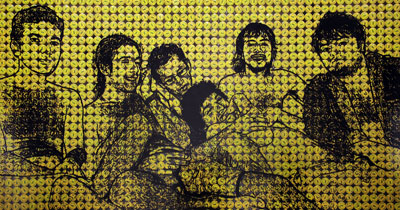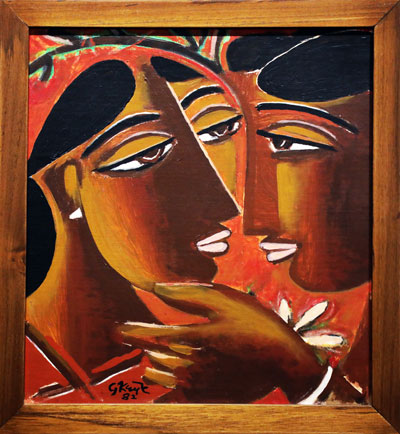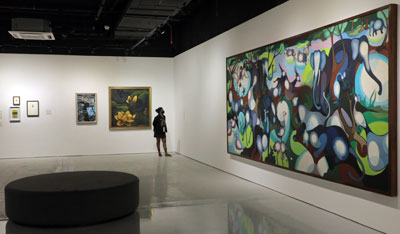MMCA: Art for the people
Walking into the Museum of Modern and Contemporary Art Sri Lanka’s new location within Crescat Boulevard, you’ll see the ghosts of past spaces on its floors. Its floors betray the infrastructural hemming that has taken place to make the museum – the seams of eight – nine shops that previously occupied the area before the shopping mall’s refurbishment are lightly visible. There’s care taken into building a museum experience within a mall for visitors – visitor educators hover expectantly in case you have questions about the work, the space is partitioned and there are details embedded in the display to enable a narrative flow. Look up and the ceiling vanishes into open fixtures painted in dark colours, making peace with a semi-industrial finish.
The Museum of Modern and Contemporary Art (MMCA) Sri Lanka reopened to the public last month, with its second exhibition ‘Encounters’ in its new location within Crescat Boulevard. ‘Encounters’ is curated by Sharmini Pereira, Chief Curator and Sandev Handy, Assistant Curator. Both the exhibition and the museum in its current iteration offer a cultural lens to understand gradations of the socio-political moment Sri Lanka is suspended in.

The intimacy of friendship: As seen through Pradeep Thalawatta’s ‘Athi Vishesha’ (Extra Special) and George Keyt’s The Friends (left). Pix by M.A. Pushpa Kumara
Established in 2019, the MMCA Sri Lanka is a privately funded initiative that seeks to establish a public museum dedicated to the display, research, collection and conservation of modern and contemporary art in Sri Lanka. As the museum lacks a permanent collection for now, the curators began piecing together works from private collections, libraries and state institutions. The works in the current collection stand in dialogue with one another, playing on running motifs, and conversing with themes and moments which taper down from national, regional and the personal. Six pieces from the George Keyt Foundation and John Keells Holdings’ art collections form the foundation of the exhibition. These are juxtaposed with artistic work responding to these paintings, thus arising in ‘encounters’.
For instance, Pradeep Thalawatta’s work, ‘Athi Vishesha’ (Extra Special) (2008), which tackles the intimacy of friendship in a private setting using arrack bottle caps as its canvas, stands in conversation with George Keyt’s ‘The Friends’ (1982) which also depicts a moment of ambiguous intimacy between two figures. In another display, the theme of family is unpacked through various art works.
The initiative’s peripatetic beginnings, budget constraints and its move from Colombo Innovation Tower has meant a truncation of space – from 5,000 square feet, the museum now has 3,800 square feet. As a result, the current exhibition that continues till August has three different rotations and is tightly curated. “We wanted to do something well, in a small way,” says Sharmini, noting that the themes the exhibition tackles lend itself to numerous curatorial possibilities.
Its move, the curators explain, was a decision to improve the museum’s accessibility to the public.
The MMCA returns with a few priorities. Art education and public engagement are a key focus since its inception. Over the weeks there have been trilingual public events, talks and tours engaging with the motifs woven within ‘Encounters’ or on personal artistic practices and Colombo’s cultural scene – events have ranged from reading Sri Lankan history through stamps to a Valentine’s Day art tour. The descriptions which accompany the work are trilingual and shun jargon-heavy artspeak which has taken root in parts of the local art scene – there’s just enough contextual detail to educate and interest but not overwhelm or obfuscate.
The team has also taken care to ensure that there are points of engagement with the exhibition and school curriculum to attract schoolchildren. “One of the ways we do that is to map schools and local and international curriculums, and then look at touch points in the research that we are doing with what is already being taught to schools,” says Sandev. “This room,” he gestures to the works in display 1, “has multiple touch points that are covered in the art, art history and social studies curriculums – from the Non Aligned Movement, Senaka Senanayake to writers of Sri Lanka and more.”
For artists, this kind of accessibility and art education is vital. “The important part of the MMCA and what I am looking for and what they are engaging with is the educational part,” notes Pradeep Thalawatta, whose work forms a part of the current rotation, emphasising that short-term gallery tours and festivals often lack sustained art education engagement. For contemporary artists, the museum also provides credence in the local cultural survival system decided by collectors, buyers, writers and historians and speaks to curatorial power, he explains.
‘Encounters’ also converses with changing geographies and cultural scenes in Sri Lanka and how the country stands at this point in time.
A part of the first display plays with the lotus motif that is embedded in Sri Lankan iconography. A 2016 stamp of the Lotus Tower optimistically portrays Lotus Tower as a new Colombo landmark, a shorthand for the city’s development drive and transformation into a South Asian metropolitan as well as a mark of Sri Lanka-China relations. Conversely, Halik Azeez’s photograph of the Lotus Tower plucks the tower from the foreground and relegates it to a peripheral reflection in a mirror held up by a young girl, surrounded by the debris of a broken building, and frames it as a reminder of how a version of Colombo was razed for a new Colombo to be formed. Reflected on the glass sheen of the photograph is advertising material outside of the Museum announcing golf and country resorts and “holiday homes for the exclusive”– in as much as the work inside invites reflection, the MMCA’s choice of new location and its beginnings also opens up conversations about a changing country and the cultural scapes of the future. The newly refurbished Crescat is one of the older, smaller shopping malls in Colombo looking to compete with the mixed development projects and newer malls mushrooming within the city. Globally, there is a cultural precedence of museums within malls – when commercial spaces are urban development priorities for a city, how will this transform its cultural spaces and its public?

Covering much ground in one room: Senaka Senanayake’s paintings, snapshots from the Non-Aligned Movement and local writings
Painted in dark tones and in a social realism style, a movement which turned to realism to make art discernable to the wider public and draw attention to the conditions of the working class, in Asai Rasiah’s 1970 painting we see a craftsman living and working in a single room with his wife and newborn child. The piece corresponds with themes of family in the last display, along with paintings by Richard Gabriel and Keyt. Susiman Nirmalavasan’s poignant ‘White Curtain and Women’ (2016) offers a fitting finale for the current rotation – life-sized depictions of 12 women whose family members had disappeared or lost their lives in the conflict. The 12 women are drawn in charcoal, acrylic and burnt wood on handloom cotton panels, the rippling of fabric offering a lifelike fluidity to the figures.
“When we set this up, it was very much a priority to see this as having public benefit,” says Sharmini, reflecting on the MMCA’s wider cultural role. Something that the MMCA has been trying to do is to untangle art as something that is seen as the preserve of a certain social class, and to broaden the art public – people who have perhaps heard of artists such as George Keyt but who have never set foot in a gallery, she explains.
Outside of its activities around the ‘Encounters’ exhibition, the MMCA completed a mapping of the expertise needed in Sri Lanka’s museum industry and is set to have a Museum intensive training programme towards the end of the year with a focus on audience engagement, inviting participation from other museums in Sri Lanka.
The goal, eventually, is to have a permanent home as a museum for visual culture focusing on 20th and 21st century art and more from Sri Lanka. However, to get there involves preparing the conditions for this — from the storage of art to conservation to facilitating research and encouraging career opportunities and more. Although the pandemic and economic conditions pose challenges, the team remains hopeful. For now, there’s work to be done.
Rotation 01 of ‘Encounters’ continues till April 10. Rotation 02 will be on display from May 5 – June 19.
For more information about free events, tours and the exhibition, please visit http://mmca-srilanka.org/
Searching for an ideal partner? Find your soul mate on Hitad.lk, Sri Lanka's favourite marriage proposals page. With Hitad.lk matrimonial advertisements you have access to thousands of ads from potential suitors who are looking for someone just like you.


